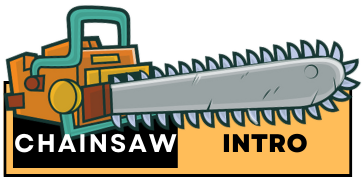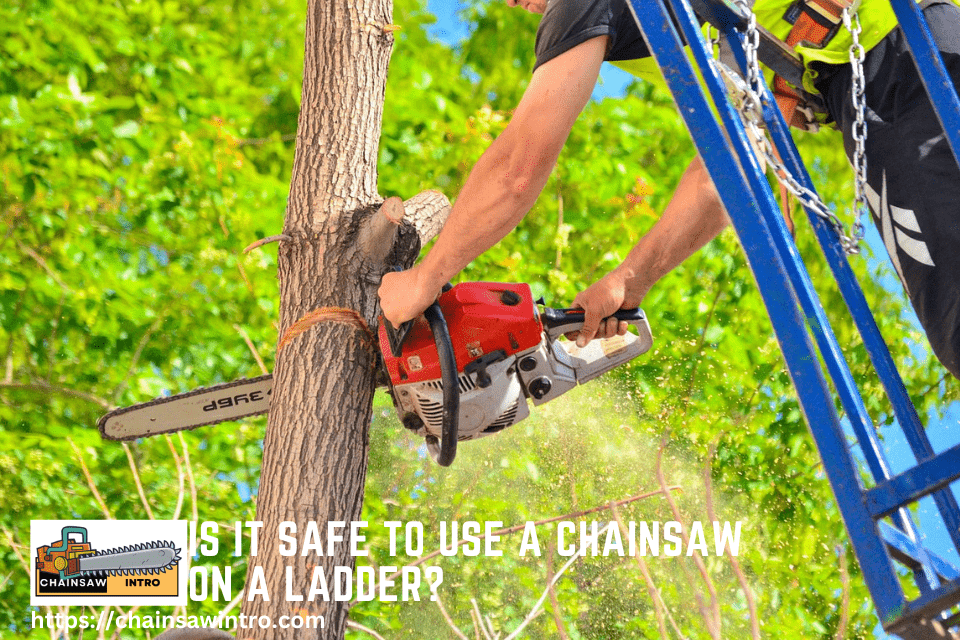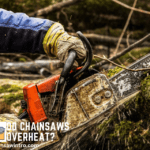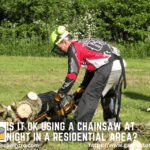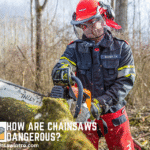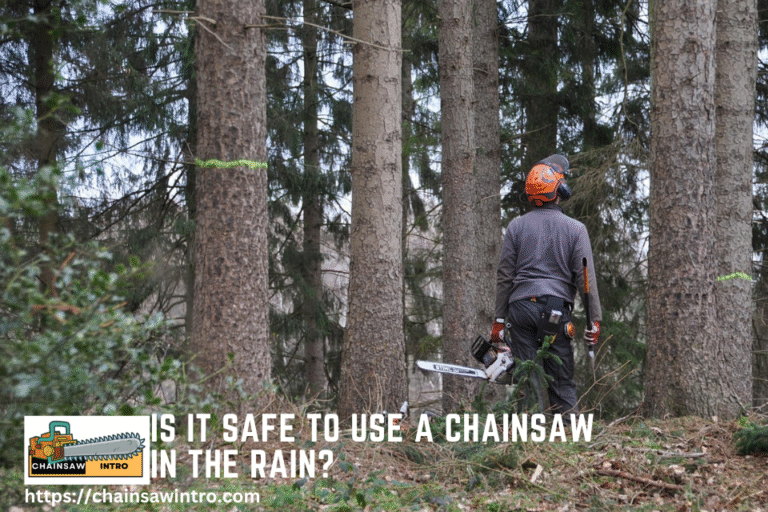Using a chainsaw is already a task that demands extreme caution. When you combine that with standing on a ladder, the danger level multiplies. Many beginners and even experienced homeowners ask: “Is it safe to use a chainsaw on a ladder?” The short answer is no—it’s not safe. In fact, most safety experts, manufacturers, and professional loggers strongly discourage it. Below, we’ll explore why using a chainsaw on a ladder is dangerous, the potential risks, and safer alternatives to get the job done.
Why Using a Chainsaw on a Ladder is Dangerous?
A chainsaw is a powerful and heavy tool that requires balance, a firm stance, and controlled movements. Ladders, on the other hand, are inherently unstable. The moment you combine the two, several hazards emerge:
- Loss of Balance – Operating a chainsaw requires both hands and a stable position. On a ladder, even slight movement can cause it to wobble, throwing off your balance.
- Kickback Risk – Chainsaws can experience kickback if the chain tip touches wood at the wrong angle. On solid ground, you may be able to control it, but on a ladder, the force can easily knock you off.
- Falling Hazard – Falls from ladders are one of the most common home accidents. Adding a running chainsaw increases the likelihood of life-threatening injuries.
- Restricted Movement – Ladders limit your ability to reposition yourself. If a branch shifts unexpectedly or your saw binds, you may not be able to react quickly.
Chainsaw Kickback and Ladders: A Deadly Combination
One of the most dangerous situations when cutting is chainsaw kickback. Kickback happens when the chain tip makes sudden contact with wood, causing the saw to jerk backward violently. If this occurs while you’re standing on a ladder, your chances of staying balanced are slim. This is why professional arborists almost never cut while standing on a ladder with a chainsaw—they use specialized climbing gear, bucket lifts, or pole saws.
Why Manufacturers and Experts Advise Against It?
Chainsaw manuals and safety guidelines from brands like STIHL, EGO, and DeWalt explicitly warn against ladder use due to the high risk of falls and loss of control. The Occupational Safety and Health Administration (OSHA) and arborist associations like the International Society of Arboriculture (ISA) recommend ground-based or elevated platform alternatives for tree work, citing ladders as unsuitable for chainsaw tasks. The primary concerns include:
- Lack of Stability: Ladders, especially extension types, can wobble or slip, particularly on uneven ground or when leaning excessively.
- One-Handed Operation: Cutting on a ladder often requires one hand to stabilize yourself, reducing control over the chainsaw and increasing kickback risk.
- Fatigue and Focus: Balancing on a ladder while cutting is physically taxing, leading to fatigue that impairs reaction time and judgment.
Professionals on forums note that even with precautions, the risks often outweigh the benefits, especially for non-experts. Instead, they advocate for safer methods to achieve the same results.
Safety Guidelines from Experts
According to the Occupational Safety and Health Administration (OSHA) and chainsaw manufacturers like Stihl and Husqvarna, using a chainsaw on a ladder is highly discouraged. Their guidelines emphasize that chainsaws should only be used on solid, level ground with proper footing.
If the job requires cutting at height, experts recommend:
- Using a pole saw to reach high branches safely from the ground.
- Renting a bucket lift (cherry picker) for professional-level jobs.
- Hiring an arborist if the work is complex or involves large trees.
Real Dangers: Injury Statistics
Every year, thousands of people are injured in chainsaw-related accidents. According to U.S. Consumer Product Safety Commission data, chainsaws cause over 30,000 injuries annually. Many of these accidents involve improper use, unstable footing, or lack of protective equipment. Using a ladder only increases these risks.
Common injuries from ladder-and-chainsaw accidents include:
- Severe cuts or amputations from loss of control.
- Broken bones or head trauma from falls.
- Electrocution if working near power lines.
Safer Alternatives to Using a Chainsaw on a Ladder
If you need to cut tree limbs or trim at height, there are safer tools and methods available:
1. Use a Pole Saw
Pole saws (manual, electric, or gas-powered) extend your reach by several feet, allowing you to trim branches without leaving the ground. This is the safest option for most homeowners.
2. Work from a Bucket Lift or Platform
If you have tall trees or complex cutting to do, renting a bucket lift provides a stable platform. Many tree-care professionals rely on this method for overhead cutting.
3. Rope and Harness Systems
Arborists use climbing gear with ropes and saddles for tree work, offering better control and safety than ladders. This requires training but is standard in professional tree care.
3. Hire a Professional Arborist
When in doubt, hiring a certified arborist is the safest solution. They have the training, tools, and protective equipment to perform tree work without unnecessary risks.
Safety Gear is Essential
Even if you’re not on a ladder, chainsaws require full personal protective equipment (PPE):
- Chainsaw chaps or cut-resistant pants.
- Steel-toe boots with good traction.
- Hard hat and face shield.
- Safety glasses and ear protection.
- Heavy-duty gloves.
This gear won’t prevent all accidents, but it significantly reduces injury severity.
When Is It Ever Acceptable?
There are very few cases where professionals might operate a chainsaw from a ladder—but it’s always with additional safety precautions. For example, specialized tripod ladders with wide bases provide more stability. Even then, arborists prefer harnesses, ropes, or bucket lifts over ladders.
For homeowners, the rule is simple: do not use a chainsaw on a ladder. The risks outweigh the benefits.
Conclusion: Prioritize Safety Over Convenience
So, is it safe to use a chainsaw on a ladder? The answer is a resounding no.
Using a chainsaw on a ladder is generally unsafe due to the high risk of falls, kickback, and loss of control, as warned by manufacturers and professionals. Safer alternatives like pole saws, bucket lifts, or hiring arborists offer effective solutions for elevated cutting without compromising safety. If ladder use is unavoidable, strict precautions like a stable ladder, safety harness, and lightweight chainsaw are essential, but risks remain. Whether you’re pruning a backyard tree or tackling professional tree work, prioritize stable platforms and proper gear to ensure safety and efficiency.
Instead of risking your safety, explore safer alternatives like pole saws, bucket lifts, or professional services. Remember: when it comes to chainsaws, safety should always come first. Assess your options, invest in safer tools, and cut with confidence from solid ground!
Frequently Asked Questions
Can you safely use a chainsaw on a ladder?
No. Using a chainsaw on a ladder is extremely dangerous due to instability, kickback risks, and the high chance of falls.
What are safer alternatives to using a chainsaw on a ladder?
Safer alternatives include using a pole saw, working from a bucket lift or platform, or hiring a professional arborist.
What safety gear should I wear when using a chainsaw?
Always wear chainsaw chaps, steel-toe boots, a hard hat, face shield, safety glasses, ear protection, and heavy-duty gloves.
Is it ever acceptable to use a chainsaw from a ladder?
Only in very rare professional scenarios with specialized tripod ladders, safety harnesses, and additional precautions. For homeowners, it’s strongly discouraged.
What are the main dangers of using a chainsaw on a ladder?
Dangers include loss of balance, severe cuts, falls, kickback injuries, and potential head or limb trauma.
I’m a chainsaw expert with over 8 years of hands-on experience in forestry, landscaping, and property maintenance. Over the years, I’ve worked with top brands like Stihl, Husqvarna, and Oregon, and I’m certified in chainsaw safety and maintenance practices. My goal is to share practical guides, honest reviews, and proven safety tips to help homeowners, DIYers, and professionals use chainsaws more effectively and confidently.
